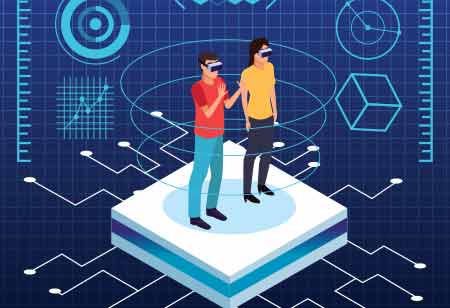THANK YOU FOR SUBSCRIBING

A Framework Approach for Introducing and Driving Use of Artificial Intelligence
Dr. Yves Gorat Stommel, Deputy Head of Function Evonik Digital, Evonik Digital

 Dr. Yves Gorat Stommel, Deputy Head of Function Evonik Digital, Evonik Digital
Dr. Yves Gorat Stommel, Deputy Head of Function Evonik Digital, Evonik Digital The adoption of digital methodologies and technologies like blockchain, Internet-of-things (IoT), augmented and virtual reality (AR/VR), and artificial intelligence (AI) are driving digital transformation across industries. Some of these technologies, like AI, can be characterized as general-purpose technologies, meaning that they can be deployed throughout an organization, be it as a part of – or even a defining element of – processes, products, and business models. AI is a topic relevant to everyone. Considering this broad applicability, a key question quickly arises for historically non-AI-centric companies: How to introduce and leverage AI broadly and sustainably?
Some organizations have approached AI in a decentralized manner, using individual development, targeted hiring, collaborations, or outsourcing to external suppliers. While initial projects (often marketed as ‘lighthouses projects’) support the learning process, they are often not easily scalable and remain limited to a small user group.
Another observation is that organizations – specifically once they observe fragmentation, parallel efforts, and even friction between ‘digital’ teams – assign a person (i.e., a chief digital officer / chief data officer) or team (i.e., a digital transformation team) to take responsibility for holistically shaping the use of these technologies across the organization. The challenge with this approach lies in the sheer breadth of the required capabilities and ‘building blocks,’ for example, a coherent employee information approach, capability building at various user and expert levels, the required IT/OT infrastructure, use case processes, an ecosystem of suppliers & partners, and suitable rules & regulations. Covering these in a single team and for all relevant domains seems difficult to achieve.
For these reasons, when it comes to digital transformation, Evonik is increasingly working with the concept of the strategic framework, which is understood to be a systematic and collaborative approach that contains a structured set of reusable and adaptable elements to achieve a desired outcome. The strategic framework provides guidance in complex organizational settings while tapping into new ideas and helps to accomplish specific goals in an agile manner.
In short, the framework approach allows bringing together stakeholders across functions and divisions to leverage individual strengths and know how to jointly work on an increasingly seamless landscape for learning about, developing, implementing, and making use of (e.g.) AI.
Working within a framework can hence be associated with 1) aligning work, setting joint goals, and celebrating successes, 2) bringing together people, building bridges and fostering diversity, 3) generating ‘top-of-mind-awareness,’ 4) providing interfaces, 5) promoting sparring and – most importantly 6) strengthening the level of acceptance by valuing the individual capabilities and know how the various parties bring to the overall framework. Share the stage!
So, what ‘elements’ or ‘building blocks’ are required for broad and sustainable AI understanding and use across an organization? It all starts with data, which – through AI expertise and on a suitable hardware and software infrastructure – is processed into information. Access to the necessary expertise is ensured not only through an ecosystem of partners and suppliers (refer to the article “Adopting and Driving AI Across an Organization by Orchestrating A Suitable Internal and External Ecosystem”) but also by hiring experts (e.g., data scientists) and training the existing workforce. Of course, AI also works within a set of internal (including data governance) and external rules and regulations. The workings and benefits of AI are communicated to the workforce through the dissemination of, among other things, success stories. Progress in implementing the AI strategy is measured using key performance indicators (KPIs). Finally, the most important element are the people in the broader organization outside of the smaller expert groups. Non-AI-expert employees determine whether AI can fully deliver on its promise. If the employees are unwilling to question (and, where appropriate, adapt) their own approaches towards AI, data sharing, and ways of working, then none of the other building blocks will be able to reach their full potential and impact.
"Do not hold back digital transformation minded people in your company by organizational structures, but empower them through a cross-organizational strategic framework approach"
While being aware and working on the above building blocks helps make progress, this technical view should not necessarily be used for communicating the framework effort to the overall company. Instead, one should be looking at the technology from the employee's point-of-view and linking the various offers in the sense of a learning and application journey.
Every learning journey starts with initial and subsequent touchpoints. Employees need to be exposed to a continuous, coherent, and sustainable stream of information on AI terminology, existing & possible use cases, advantages & disadvantages, contact partners, exchange formats, support, and – last but not least – training opportunities.
The latter is an important building block to progress to the next station along the journey: Learn and understand. A number of trainings – from an awareness training covering the main buzzwords to a yearlong data science course – have been made available at Evonik. Other, more playful formats, like a virtual escape room on the topic, have also proven to be a big draw. Additionally, various analysis tools are centrally supported in terms of easy tool access, free tool training, information material, and support rooms. After all, while going through training helps to learn knowledge and skills, real understanding comes with applying what was learned.
Which leads the employee to the next step: Applying the technology to realize potential value. This does not necessarily mean that every employee should build and deploy their own AI solutions. However, knowing about the technology allows identifying opportunities for the use of AI applications – either internally or externally sourced. A strong ecosystem of suppliers and partners is hence key, alongside efficient processes to channel use cases into the hands of the right providers.
Finally, for those within the company that ‘live and breathe’ data & AI, the final stop on the learning & application journey is to become part of the cross-functional team that steers the strategic framework. To jointly drive the organization towards broad use and understanding of AI.
The organizational learning & application journey has neither an obvious endpoint nor a static and/or central team. The latter might just be the reason why the approach works: Do not hold back digital transformation minded people in your company by organizational structures, but empower them through a cross-organizational strategic framework approach.
Read Also

















ON THE DECK